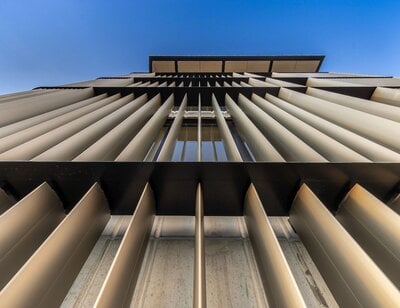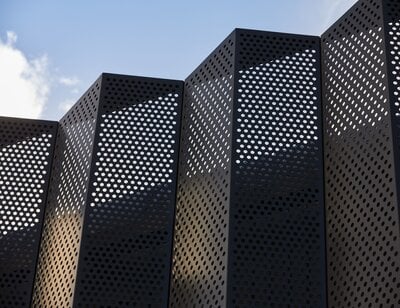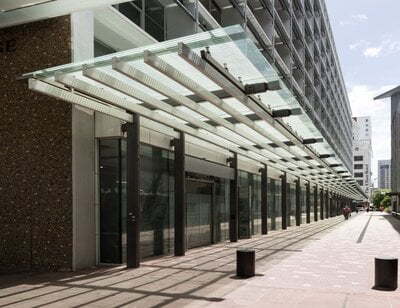The earth revolves around the sun in more ways than the orbiting kind. Just how we adapt and react to the sun can affect the quality of life in obvious and surprising ways. Calculating this effect can be tricky. At least, some of it can. Some of it is just mathematics and we've developed calculators to do that for you.
If you want to jump right in and use them, then skip to the bottom of this blog. But if you want to learn more about why they are important, then please read on. You might find it... illuminating.
Architectural Design & Sun Shading
Sun responsive architectural designs such as louvres, overhangs and vertical fins generally remain static. This makes their position pivotal for success and they must work with the sun's dynamics to provide the best possible shading solution. The function of the building will add extra criteria to their shading requirements and emphasises the importance of adjusting the design to work with the sun's influence on the interior and its occupants. Considerations include:
Visual Comfort
Computer screens and tablets are generally very reflective and despite the ability of most modern equipment to automatically adjust the display in different lighting conditions, there is still a risk of glare from sun reflection. This can cause a myriad of issues, including eye strain, fatigue, headaches, blurred vision and dry eyes.
Even a moderate amount of glare is known to have a moderate effect on concentration, with the associated knock-on effect on productivity. In the Office, this has a direct, contributable financial cost to the bottom line. In a learning environment (i.e. school classrooms) the effect is felt through reduced comprehension and sub-standard advancement for students (vs anticipated progress).
Glare is not only limited to reflective surfaces but can also be 'generally experienced' should sunlight be at the right angle (which is really the wrong angle).
Thermal Comfort
Thermal comfort is based on skin temperature and sweat secretion. To be considered 'comfortable', these two factors have to be balanced within an acceptable range. The Fangar developed PMV and PPD Models informed the guidelines enshrined within the globally recognised ASHRAE 55 and ISO 7730 standards, which define thermal comfort as 'that condition of mind that expresses satisfaction with the thermal environment'.
PMV predicts the temperature at which the average occupant will be comfortable. PPD predicts what portion of occupants will be unhappy with a specific set of temperature and conditions. The difference between the two is just a few degrees. A PMV in excess of +0.5 in a new building will result in significant occupant thermal discomfort. This ‘overheating’ is not only dangerous to health but also has significant implications for productivity. For example, where the temperature moves upwards of 25℃ (77℉), productivity starts to drop by 2% for each additional ℃, as represented as P % = 2 x (Temp, ℃) - 50.
For an office building, the optimum temperature for productivity is considered to be between 22℃ (72℉) and 25℃ (77℉). Outside of this range, there are noticeable differences in employee performance.
In a school setting, excessive heat build up and thermal discomfort has even more dramatic consequences. The National Bureau of Economic Research at Harvard, studied PSAT scores for a 13 year period up until 2014. With a sample of over 10 million students over the prolonged research period, the conclusions are irrefutable. It found that, on average, a school year that was hotter by 1℉ (0.56℃) correlated to a loss of 1% of the years learnings.
Sustainability
Heating and cooling a building typically accounts for around 40% of the total building energy consumption. If the shading provided by louvres is sub-optimal and does not take into account the sun’s location and path, mechanical assistance will be needed and pressure put on the HVAC system. A clever design, with the shading calculated effectively, has proven to reduce this energy burden significantly. In some cases, the correct use of louvres have proven to reduce the total energy consumption by 50%.
That financial saving and the associated reduction in energy consumption would seemingly more than pay for the louvre installation, in some cases within a very short period of time, while aiding businesses in meeting their sustainability goals. The same can be said of schools and educational institutions. Given the general lack of funding for education, the savings to be gained would likely go some way to improving an often perilous financial position.
Sun Shading & Schools
Using properly positioned and designed shading devices is an expansively covered topic in research and literature from the Ministry of Education. The former informed and influenced the latter with the groundbreaking ‘Clever Classrooms’ study by the University of Salford (Manchester), which has formed the basis for many of the best practice guidelines and requirements laid out in the MoE publication, ‘Designing Quality Indoor Learning Spaces: Indoor Air Quality and Thermal Comfort’.
Central to both is the finding that “difference in the physical characteristics of classrooms explain 16% of the variation in learning progress over a year”. It’s estimated that the effect of moving a child from the least effective space to the most effective space is around ‘1.3 sub-levels’. A child typically progresses by 2 sub-levels per year so the effect is significant.
This makes the use of shading calculators all the more important as a tool to ensure the shading requirements of the classroom are fully optimised.
Using Insol’s Shading Calculators
The year round performance of sun shading from louvres and fins is dependent on their exact position, orientation and measurements. They have to take into account where the building is, what it’s facing and the times of the day the building is used. That may not vary greatly but there might be the exception. For example, the neighbourhood gym which is typically at its busiest between 5am and 7am, then again after 5pm, when direct sunlight in summer might be a significant issue.
All of this taken into account and analysed with the assistance of the Insol Shading Calculators. These free tools can be used to:
- Calculate the shading provided by either a horizontal or vertical louvre system.
- Calculate the shading provided by vertical fins on a window or a wall.
- Visualise the degree to which horizontal overhang shares a window during the year.
- Gain visual feedback about the performance of a horizontal window overhang.
You’ll find guidance on how to use them but for the most part, they’re relatively intuitive. Just input the position of the window and the measurements of the shading system, and the calculators will show you the shading provided throughout the day at various times of the year. They’re free to use, and can be used as many times as you like.
For more information or to discuss shading needs for a particular project, please contact us.








